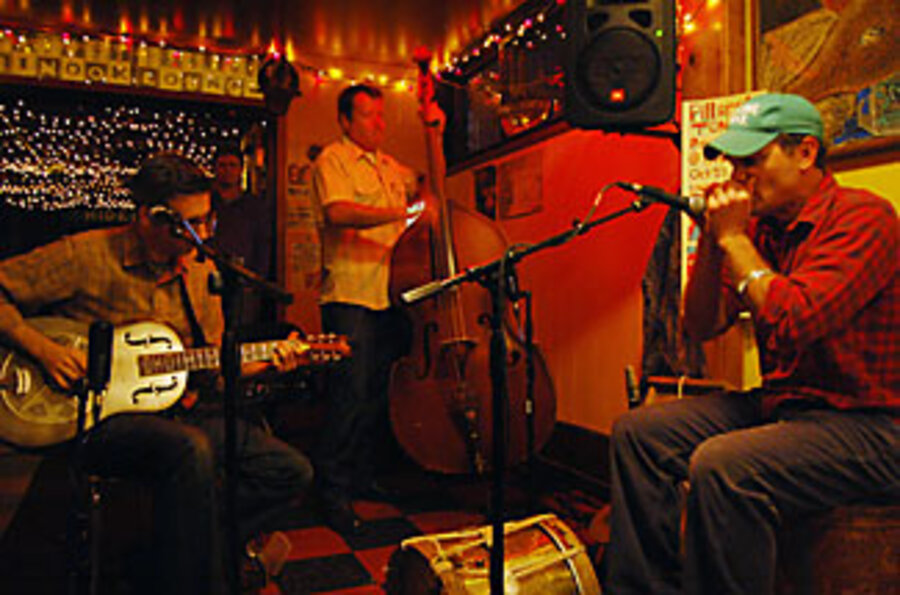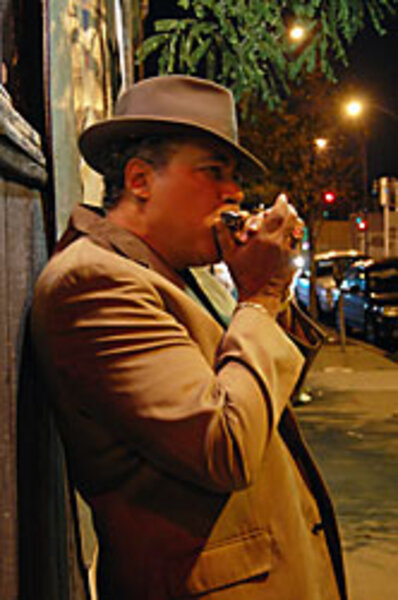The changing face of Chicago blues
Loading...
| Chicago
Billy Branch steps off the stage and into the crowd, leaving his band to chug through a 12-bar blues. With a harmonica pressed to his lips, Branch sends light, flirty chirps to a woman, just inches from her face. For a single moment, the hundred or so people at Rosa's Lounge on Chicago's West Side fall silent.
The woman slips into the groove and joins Branch's musical conversation, and everyone around follows her cue.
Branch barks his biography – "I was born in the North, but my heart is in the South!" – and the band guns it. His heels spin to join them.
Here, on a Saturday night in October, it is a familiar conquest: Targeting lips to hips is what makes Chicago blues so enduring. But movement of a different sort, through geography and generation, is what also makes it deceptively complex.
That journey is threatening to jump the track. The music is largely silent in the Chicago neighborhoods where it originated, due to a shuttered club scene that moved audiences to the North Side, near the friendlier confines of Wrigley Field. But more alarming is the increased passing in recent years of aged blues luminaries, an inevitable loss of stories and techniques that connect the music to its fundamental roots.
Today, the Chicago blues scene is in stark transition. Younger blacks are failing to see the music as anything but a relic, leaving an entire tradition largely up for adoption by foreign-born players traveling halfway around the world to learn from the source. Their enthusiasm is helping move the blues from isolated neighborhoods to the global stage, evidenced by Chicago bands that very recently have come to resemble a United Nations portfolio.
This cultural exchange is expanding the music's songbook with stories it never addressed before and is helping create sophisticated players schooled as much in Van Halen and Led Zeppelin as they are in Muddy Waters and Howlin' Wolf. But advocates worry that the flashy guitar tones and studied technique threaten to replace the personal expression that has long made the music profound.
In Chicago, blues music has always lived, not through television documentaries or books, but primarily through people – the Southerners who populated the city's South and West sides and who helped pass the music's foundation on to the next generation. For this reason, the blues has always been a collaborative pact between fathers and sons, uncles and nephews, the grizzled mentors and the eager young followers who sought them out, either from the other side of town or from as far away as Japan.
"There is a crisis," says Tony Mangiullo, owner of Rosa's Lounge, which marks its 25th anniversary next year. Mr. Mangiullo is a record keeper of this turning point in Chicago blues history; he keeps a database of musician deaths, which these days can be every other month. "If we keep losing those important links, it could be catastrophic."
Younger players may neglect in their playing what Eddy Clearwater calls "a spiritual thing." Clearwater arrived in Chicago from Birmingham, Ala., in 1950 when he was 15. (This fall, he released "West Side Strut" [Alligator], his 16th album.) In the '50s, an agent changed his last name from Harrington to Clearwater, a riff on Muddy Waters; Clearwater was honored.
"He's my all-time hero. He took me in. He used to call me son," Clearwater says.
Clearwater embodies the total Chicago sound. His polished performance style is what Waters helped shape on the South Side, but his guitar style – minor chords, gutbucket distortion, raw phrasing – is identified with Magic Sam, Elmore James, and others who developed the West Side sound and whom Clearwater listened to and watched as he grew up.
Back then, music filled those neighbor- hoods when nightclubs and taverns became incubators for experimentation and collaboration, and the dozens of record labels on South Michigan Ave. sent the results to the world.
Today, only a handful of clubs on the South and West sides feature live music – the rest fell victim to the crumbling infrastructure created by the race riots of the 1960s, widespread factory closings, and gentrification. Younger blacks largely turned away from blues and toward music they considered more contemporary: soul and funk.
"All of your blues clubs were in dominant black areas. You didn't hear of a blues club in the white areas. So now it's totally the opposite," Clearwater says. "Now, more white people support the blues. I hope black people realize it's their own heritage."
Branch has held court at the Artist's Lounge on E. 87th St. every Monday for 22 years precisely for this reason: "To keep the music in the community." Also an educator, he has traveled the world since 1978, giving week-long clinics to teach blues harmonica to schoolchildren and show them how the blues can be a relevant mode of expression in their lives.
"The main reason black kids can't grasp onto it is they're not afforded the availability. It's not played on the radio, and you don't see it on television," he says.
How far Chicago blues spread outside its neighborhoods becomes clear upon any visit to a club bandstand. There, the visitor may encounter either Shun Kikuta or Guy King, two guitarists who made a beeline to Chicago from Japan and Israel respectively to learn the music they only knew through recordings. They represent a new generation that sought mentors to learn the music's fundamentals, but would never assume to represent its past.
"We still do play the 12-bar style, but the sound is much heavier. In traditional blues, there's more space between notes. But nowadays, because of the funk and rock influences, that sound is more concentrated," says Kikuta, who came to Chicago in 1990 and now plays guitar for blues luminary Koko Taylor. His recent album connects Chicago blues to his own heritage with the use of a shamisen, a three-string traditional Japanese instrument that dates back to the 16th century.
On "Livin' It" (IBF), his just-released first album, King uses the blues to talk about religion and the battle over land rights in his home country. "Some people will say it's not really blues. But I think the blues has been misinterpreted. They will tell you it's old people's music, but if you think about it, the legends were all young when they made it. Robert Johnson died when he was 28," he says.
As much as Chicago blues is changing to tell new stories or incorporate different sounds, there remain musicians who consider its earliest and simplest incarnation, the pre-electric era of the 1930s and 1940s, as the most relevant.
"I'm burnt out on the electric stuff, it seems what they're doing is headed more towards tourists," says Rick Sherry of Devil in a Woodpile, a trio that for the past 12 years has played every Tuesday night at the Hideout, a cozy bar and music room tucked inside the North Side's industrial corridor.
Long ago the band decided it would play on the floor and not a stage to make the music more intimate. On a recent Tuesday in October, 20-year-olds crowd so close to the band that guitarist Joel Patterson has to lean over while playing so as not to block the line for the bathroom.
Sherry, who plays washboard and clarinet, and kicks a 1916 drum at his feet, gets couples dancing with early 20th-century standards from Charlie Patton, Fats Waller, and others who date back to a time when musicianship was more physical: Players could not rely on amplification to be heard.
"It was like a niche that was untouched," he says. "I'm not stealing anything from anyone. I'm stealing everything from everyone. People like this music."






